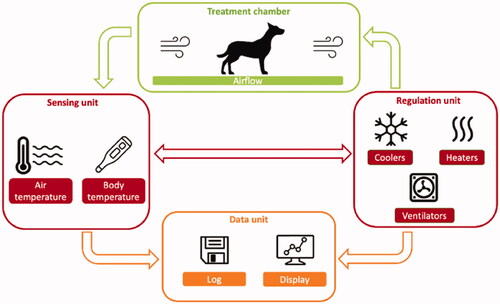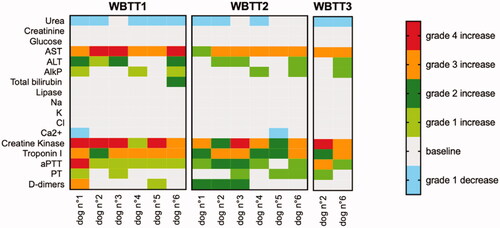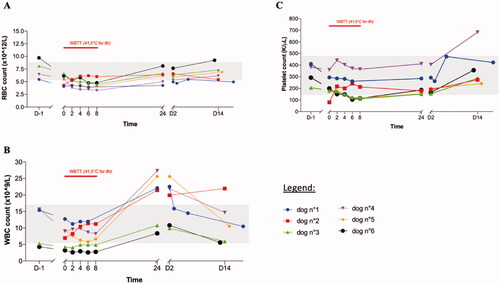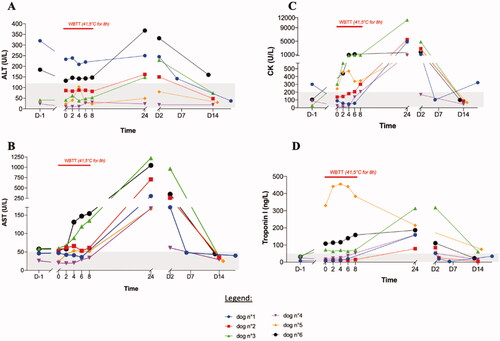Figures & data
Table 1. Patient characteristics, tumor types and individual treatment regimens.
Figure 1. Schematic diagram of ElmediX HyperTherm G3.5 medical device components. Four units can be identified in the device: (1) the treatment chamber; (2) the sensing unit; (3) the regulation unit; and (4) the data logging unit. Hot air is injected at high speed in a treatment chamber. Air temperature is modified, to reach and maintain a liver/body temperature of 41.5 °C. All optical fiber sensor data are logged simultaneously on a personal computer for control and data reporting.

Figure 2. Comparison of the maximal liver, rectal and tumor temperatures monitored during whole-body thermal treatment. (A) dog n°1, WBTT1 (there was no monitoring of the rectal temperature with ElmediX sensors during this case, only with a standard hospital probe); (B) dog n°2, WBTT2; (C) dog n°3, WBTT1; (D) dog n°4, WBTT1; (E) dog n°5, WBTT1; (F) dog n°6, WBTT3. During plateau-phase, there is a fluctuation of temperature around the set-point (41.5 °C). Over time, the temperature accuracy improved (A and B as compared to F). By adding extra heating patches on superficial tumors located far from the core, treatment temperature at 41.5 °C was reached (F).

Figure 3. Heatmap depicting all biochemical, electrolyte and coagulation parameters measured during whole-body thermal treatment (WBTT) and their seriousness. Per WBTT session (ranging from the day before to 14 days after the respective session) and per animal, all parameters maximally deviating from their normal ranges were selected. The seriousness of the deviation was than graded according to the VCOG-CTCAE v1.1 guideline. As shown, most parameters remained within their reference ranges. Grade 3 and 4 disturbances occur in selected parameters (liver (AST), skeletal muscle (creatine kinase), cardiac (Troponin I) and coagulation (aPTT and D-dimers)) though not systematically in each patient or during each WBTT session.

Figure 4. Effect of whole-body thermal treatment (WBTT) on selected hematological parameters. Red blood cells (A), white blood cells (B) and platelets (C) were determined the day before treatment, every two hours during the treatment plateau-phase, and then 24 h, 48 h, and 14 days after the treatment. For all parameters, a temporary drop is seen during the WBTT session. This is a dilution effect of the blood, caused by the required intense fluid therapy (10 ml/kg/h). All parameters recover quickly after the end of the procedure. Only the values of first WBTT session are shown; the same trend was seen in the other treatment sessions.

Figure 5. Effect of whole-body thermal treatment (WBTT) on selected biochemical parameters. Alanine aminotransferase (ALT (A)), aspartate aminotransferase (AST (B)), creatine kinase (CK (C)) and cardiac Troponin I (cTnI (D)) were determined the day before treatment, every two hours during the treatment plateau-phase, and then 24 h, 48 h, and 14 days after the treatment. These results confirm a heat-induced stress of WBTT on liver, skeletal muscle and heart which is mild, clinically well tolerated by the patient and transient in nature.

Table 2. Overview of Serious Adverse Events (SAEs) registered during the study, their gradation according to VCOG-CTCAE v1.1 and the relation to the WBTT procedure.
